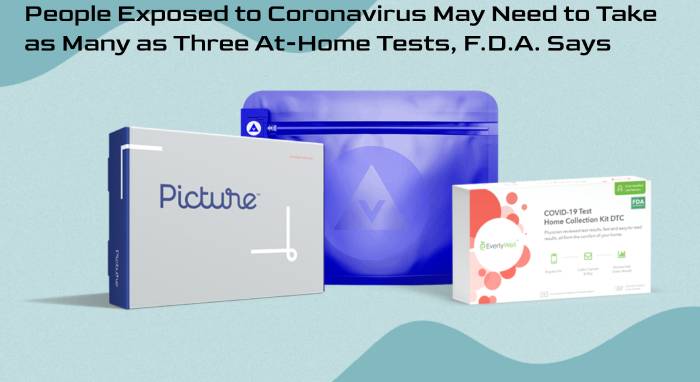According to the FDA, asymptomatic people who use Coronavirus antigen tests should take at least three tests, each spaced 48 hours apart, to reduce the likelihood of missing an infection.
According to the agency, people with Covid-19 symptoms should take two tests 48 hours apart.
As the highly transmissible BA.5 subvariant of Omicron spreads, and the Centers for Disease Control and Prevention have eased their recommendations for routine surveillance testing, the new guidelines are timely.
It has been reported that at-home tests failed to detect infections, but studies have generally shown that rapid antigen tests can detect Omicron as well as Delta, the previous variant of concern.
According to Doctor, chief science officer for eMed, which sells at-home tests, the new recommendations are “very science-based.” In some cases, it takes two days for the virus to reach a detectable level, and in others, six days.
Researchers have long noted that rapid antigen tests, which are less sensitive than P.C.R. tests, can best detect Coronavirus when used repeatedly over several days.
The new recommendations emphasize the need for “additional testing over a longer period of time.”
“The F.D.A.’s new recommendations for at-home Covid-19 antigen tests underscore the importance of repeat testing after a negative test result in order to increase the chances of detecting an infection, Doctor, director of the agency’s Center for Devices and Radiological Health, said in a statement.
This new guidance is based on the results of a new national study that has not yet been published in a scientific journal. A study led by researchers at the University of Massachusetts Chan Medical School examined 154 people who tested positive for the virus between October 2021 and February 2012.
A study found that 93 percent of infections were detected by two tests taken 48 hours apart among symptomatic people. In contrast, 63 percent of infections were detected in asymptomatic individuals using the same testing pattern.
Three tests, each two days apart, caught 79 percent of infections in people without symptoms.
Doctor, an assistant professor at UMass Chan Medical School, who led the study, said, “We provide data-based evidence on how to use rapid antigen tests.” Testing schedules are essential.
Researchers said some participants in the study had Delta infections while others had Omicron infections.
“We cannot emphasize enough how important it is that the tests are able to detect Omicron,” said Nathaniel Hafer, a molecular biologist at UMass Chan Medical School.
Even if they receive two or three negative results on at-home antigen tests, people who feel they may be infected can seek out a more sensitive P.C.R. test or consult a physician.
Those who test positive using at-home tests should assume they are infected and follow the guidelines provided by the CDC.
Covid-19 guidance was updated on Thursday, but the Centers for Disease Control and Prevention did not change its recommendation that people who test positive for the Coronavirus isolate at home for at least five days.
According to the Food and Drug Administration, people do not need to use the same brand of test every time.
If you plan to use the Covid-19 antigen test at home, make sure you have several tests on hand so you can test more than once.

